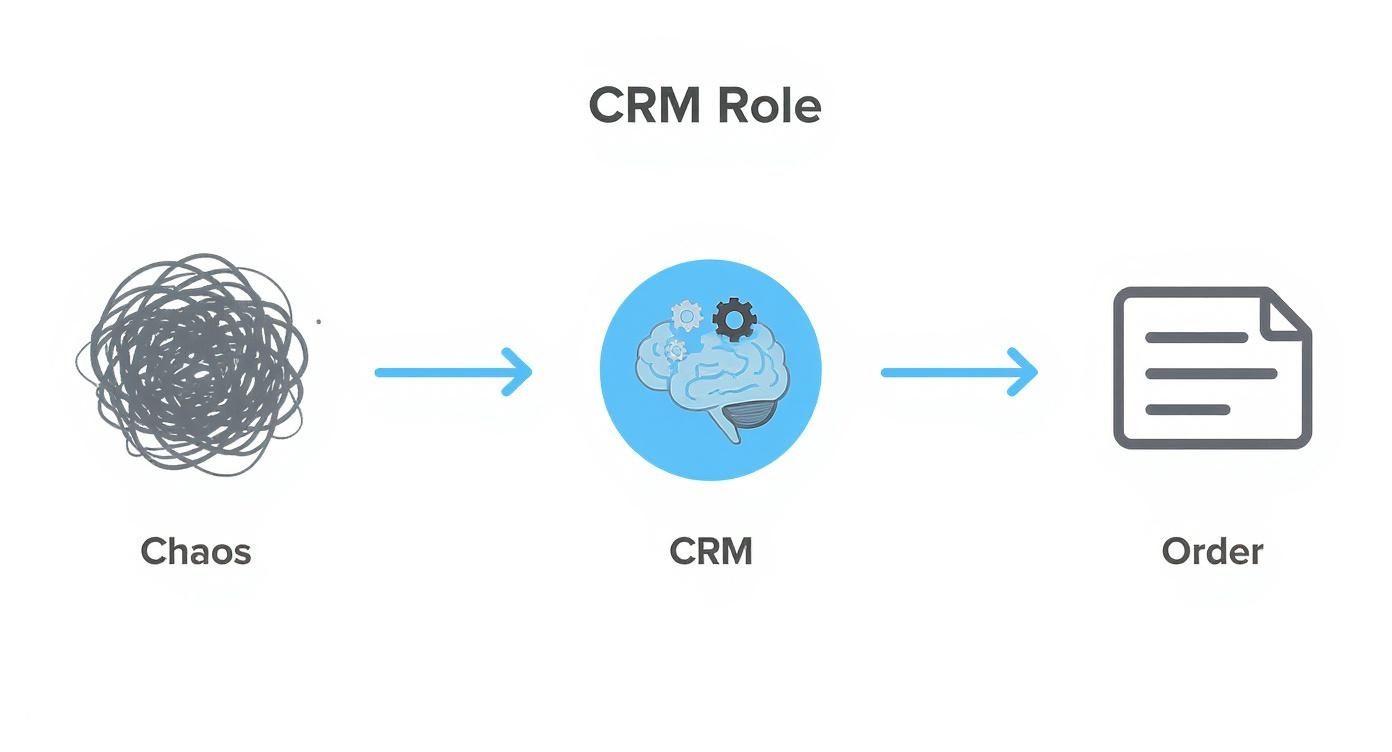Let's be honest, for too long, many of us have treated a CRM like a glorified digital Rolodex—a place to dump contacts and maybe, just maybe, remember to follow up. But thinking of it that way is leaving a ton of money on the table. Your Customer Relationship Management (CRM) system should be the absolute central nervous system of your growth strategy.
When you truly integrate your CRM with lead generation, you stop just collecting names and start building a powerful, relationship-focused engine that guides every single prospect from their very first click all the way to becoming a happy customer.
Most companies operate with a massive disconnect. Marketing works hard to capture leads through website forms, social media ads, and events, and then they essentially toss them over a wall to the sales team. It's a broken process. This handoff almost always results in lost context, spotty follow-ups, and promising leads slipping right through the cracks.
Imagine an air traffic control tower trying to manage a busy airport using nothing but sticky notes. A note for a 747 from London, another for a small Cessna from a local field, a third for a cargo plane. It would be pure chaos. Planes (your leads) would get lost, land on the wrong runway, or just circle overhead until they ran out of fuel. It’s not just messy—it’s a recipe for disaster.
This is where a good CRM steps in to be your sophisticated air traffic control system. It creates a single, unified dashboard for every lead, no matter where they came from. Every tiny interaction, from an opened email to a page viewed on your website, gets logged automatically. Suddenly, your team has a complete flight history for every single prospect.
This central hub of intelligence is where the real magic of CRM and lead generation happens. No more guessing which leads are hot and which are cold. The CRM gives you clear, data-driven signals on who's ready for a sales call and who needs a little more time.
A CRM transforms lead generation from a game of chance into a science. It ensures that every marketing dollar and every sales call is invested in the prospects most likely to convert, turning potential chaos into a predictable revenue pipeline.
At the end of the day, getting a lead is just the starting line. The real victory is turning that initial spark of interest into a profitable, long-term relationship. A CRM makes this happen by bringing order and automation to the nurturing process. The benefits are immediate and tangible:
By plugging every lead generation effort directly into your CRM, you’re building a scalable system. It's a system that doesn't just capture more leads—it intelligently guides the best ones toward becoming your most loyal customers.
Think of a CRM-powered lead generation process less like a rigid assembly line and more like a smart, automated factory. Raw interest from all over the web—your website, social media, ads—flows in one end. What comes out the other? A stream of well-qualified, sales-ready prospects. It’s all about turning scattered signals of interest into a predictable revenue pipeline.
It all kicks off the second someone raises their hand. They might fill out a "Contact Us" form, download a whitepaper, or click on a social media ad. Instead of that info landing in a messy spreadsheet or a forgotten email inbox, it's instantly and automatically piped directly into your CRM. No manual entry, no lost leads, no delays.
Once a new contact is in the system, the CRM really gets to work. It acts like a digital sorting hat, immediately figuring out who this person is and what they might need based on rules you’ve already set.
This isn't a one-size-fits-all process. The sorting can be based on all kinds of data points:
This infographic does a great job of showing how a CRM brings order to the chaos of scattered lead data.

You can see how the CRM acts as the central nervous system, taking all those tangled inputs and turning them into clear, actionable pathways for your sales and marketing teams.
After the initial sort, the CRM applies a lead scoring model. This is basically a triage system for your sales team. The system assigns points to each lead based on their profile and their actions. For instance, a director from a target industry who just requested a demo is going to get a much higher score than an intern who downloaded an infographic.
By automatically scoring leads, a CRM ensures your sales team spends 100% of their time on prospects who have shown the most interest and are the best fit for your product, dramatically increasing efficiency and conversion rates.
This prioritization is absolutely critical. After all, lead generation is ranked as the top priority for a whopping 91% of marketers. With 67.8% of marketers storing their leads directly in a CRM, it's clear the platform is the central hub for turning that interest into revenue.
Ultimately, this automated workflow ensures the hottest leads—the ones with the highest scores—are immediately flagged and sent to a salesperson for a timely follow-up. Meanwhile, the cooler, lower-scoring leads are placed into automated email sequences to nurture them over time, keeping your brand top-of-mind until they're ready to engage. Nothing falls through the cracks.
To get the most out of this system, it helps to pair your CRM with proven lead generation best practices.
Getting a lead into your CRM is just the first step. The real work—and the real magic—happens next. This is where your CRM stops being a simple database and becomes a tireless, 24/7 assistant, building relationships and moving deals forward while you sleep. Automated nurturing workflows are the key to making this happen, letting you build trust and guide prospects toward a sale without lifting a finger.

Think of these workflows as pre-planned conversations. Each one is designed to send the perfect message at the perfect time, all based on a lead’s profile and what they do. The entire goal is to stay helpful and keep your brand front and center in their mind.
The best CRM and lead generation workflows aren't just based on a calendar. They’re based on behavior. Instead of blindly sending an email every three days, you react to what your prospects actually do. This simple shift makes your outreach feel helpful and relevant, not like spam.
It all runs on simple but powerful "if-then" logic:
This kind of dynamic response ensures every touchpoint makes sense in the context of their journey.
Automated lead nurturing isn't about blasting your list with generic messages. It's about creating a personalized, responsive experience that guides each person based on their unique digital body language. It makes them feel seen and understood.
While you could build a workflow for almost anything, it's best to start with the fundamentals. A few core sequences can provide the foundation for a solid lead nurturing strategy and deliver some quick wins by making sure your follow-up is consistent and effective.
Here are three essential automated campaigns to set up in your CRM right away:
By putting these automated sequences in place, you create a safety net that ensures no lead falls through the cracks. You build a system that intelligently manages relationships at a scale you could never do manually, freeing up your sales team to focus on what they do best: closing deals with your most engaged prospects.

Think of your CRM as more than just a digital address book. It's a treasure chest, packed with actionable data just waiting to be uncovered. When you look past simple deal tracking, you can turn your CRM into a strategic weapon for pipeline growth and constant improvement. This is where CRM and lead generation truly click, paving the way for predictable revenue.
The real magic happens when you use your CRM's reporting and analytics to ask the tough questions. Where are our leads getting stuck? Which specific actions are most likely to move a deal to "closed-won"? The answers are already in your data, ready to shape your sales strategy and lift conversion rates across the entire pipeline.
Every sales process has sticking points—those frustrating stages where good leads seem to stall out or vanish completely. Without solid data, figuring out where these bottlenecks are is just a shot in the dark. Your CRM’s pipeline reports, however, shine a bright spotlight on them.
By looking at stage duration reports, you can pinpoint exactly where deals are losing momentum. For instance, you might notice that leads sit in the "Proposal Sent" stage for an average of 30 days but only take five days to move past "Initial Contact." That’s a massive red flag. It tells you that your proposal, pricing, or follow-up process is creating friction. With that knowledge, you can start making targeted changes.
Your CRM doesn’t just tell you what is happening in your sales pipeline; it reveals why. Analyzing stage-by-stage conversion rates helps you identify the weak links in your process and fix them with surgical precision.
Some of the best business lessons I've ever learned came from deals we lost. Your CRM should be set up to capture the "Reason for Loss" for every opportunity that doesn't pan out. After a few months, this data starts to tell a very compelling story.
You’ll start to see patterns emerge:
By digging into these trends, every lost deal becomes a learning opportunity. If you want to go deeper on this, exploring different data-driven marketing strategies can help you connect these CRM insights to your broader marketing efforts. This proactive approach helps you adapt on the fly, fine-tune your sales pitch, and ultimately improve your win rate by tackling the real reasons deals fall through.
Artificial intelligence isn't some far-off concept anymore; it's a practical tool that's completely changing the game for CRM and lead generation. Think of it as an intelligent assistant working alongside your CRM, handling complex tasks and spotting patterns that a person could easily miss.
This isn't about replacing your team. It’s about making them better. AI takes on the grunt work—the tedious, data-heavy lifting—so your people can do what they do best: build relationships and close deals.
One of the first places you'll see AI make a huge impact is with predictive lead scoring. For years, we've relied on rule-based scoring. You know the drill: add 10 points for a Director title, 5 points for visiting the pricing page. It's a decent system, but it's rigid and often overlooks the nuances of a real buyer's journey.
AI approaches this completely differently. It digs into all your historical data—every win, every loss—to figure out what actually makes a good lead. It might find something you'd never guess, like leads who download two specific whitepapers and then visit your blog are 400% more likely to convert.
The system then applies this deep understanding to score new leads as they come in, giving you a far more accurate picture of your pipeline. Your sales team can finally stop guessing and start focusing their energy on the opportunities that are most likely to close.
Beyond just scoring, AI is also changing how we talk to prospects. Conversational AI, like the technology we build at Upcraft, can engage with people 24/7 through website chatbots and other messaging platforms. These aren't just simple bots; they can ask smart qualifying questions, book meetings right into a sales rep's calendar, and give instant answers to common questions.
Having this kind of automation means every single lead gets an immediate, helpful response, even if they reach out at 2 AM on a Sunday. The payoff is pretty clear:
When you bring AI into the mix, your CRM stops being a passive database and becomes an active growth engine. It doesn't just hold information; it engages, qualifies, and prioritizes your pipeline so your team can work smarter, not harder.
The shift is already happening. Globally, 32% of CRM adoption is driven by the need for better lead generation. And with 70% of businesses now using mobile CRM, the demand for real-time, intelligent engagement has never been higher. If you're curious, you can find more CRM usage statistics that highlight just how critical this technology has become for hitting sales goals. It's this blend of AI intelligence and on-the-go access that is truly shaping the future of how we manage customer relationships.
Picking a CRM is one of the biggest technology decisions you'll make for your business. It's easy to get this wrong. Don't think of it as just buying software; think of it as hiring a star employee to manage your most critical asset: your customer relationships. Nailing this choice is the foundation for successfully linking your CRM and lead generation strategy.
It's tempting to get lost in a sea of feature comparison charts, but the "best" CRM isn't always the one with the most gadgets. The right one is the one that actually fits how your team works, makes their jobs easier, and can scale with you as you grow.
A CRM that’s perfect for a two-person team will buckle under the pressure of a 50-person sales force. Before you sign any contracts, think about where your business will be in one, three, and even five years. The platform you choose has to handle way more leads, contacts, and data down the road without grinding to a halt or forcing you into a painful migration.
Just as critical are integrations. Your CRM can't be a silo. It needs to play nicely with all the other tools your team uses every single day:
A CRM with a healthy app marketplace saves you from the soul-crushing task of manual data entry and makes sure your entire tech stack is actually working together.
The right CRM acts as a central hub, not an isolated island. Its ability to seamlessly integrate with your existing tools is a direct indicator of its long-term value and impact on your team's efficiency.
The demand for these platforms is exploding. The global CRM market is on track to hit around $262 billion by 2032, driven by companies going digital and realizing they need to keep the customers they have. This boom gives you more choices, but it also means you have to be extra careful. You can find more insights on the growing CRM market to see where things are headed. At the end of the day, a system that grows with you and connects to your other tools will be a true partner, not just another line item on your budget.
Still curious about how a CRM can really change the game for your lead generation? Let's tackle some of the most common questions we hear.
Think of a CRM as the central nervous system for your entire lead generation effort. Its primary job is to bring order to the chaos, acting as the single source of truth for every prospect who comes into your world, whether from a web form, a social media ad, or an event.
Instead of having lead data scattered across spreadsheets and inboxes, the CRM organizes it all in one place. This allows you to effectively score, segment, and nurture leads, making sure your sales team is always focused on the hottest opportunities and not wasting time on dead ends.
A CRM takes the guesswork out of lead qualification, primarily through a process called automated lead scoring. It works by assigning points to a lead based on who they are (demographics, company size) and what they do (visiting your pricing page, opening an email, downloading an ebook).
This system creates an objective hierarchy, automatically flagging the most engaged prospects as Marketing Qualified Leads (MQLs) or Sales Qualified Leads (SQLs). A high score tells your sales team, "Hey, pay attention to this person!" It lets them prioritize their time on conversations that are far more likely to close.
The real magic here is moving from "gut feelings" to a purely data-driven approach. Your CRM systematically brings your best opportunities to the surface, so a high-potential lead never gets lost in the shuffle again.
Absolutely, and this is one of its biggest strengths. Modern CRMs are designed to be the hub of your marketing technology, connecting seamlessly with the other tools you already use. This creates a unified system where data flows exactly where it needs to.
Common integrations include:
This connectivity ensures every part of your CRM and lead generation strategy is in sync. It breaks down data silos and gives you a complete, 360-degree view of the entire customer journey.
Ready to see how intelligent automation can supercharge your lead engagement? Upcraft's conversational AI agents integrate with your CRM to qualify leads, book meetings, and nurture relationships 24/7. Discover how Upcraft can help you convert 5x more leads.
Enter your contact information and Archer will start a conversation with you via text message.